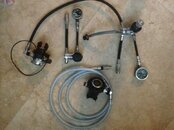DevonDiver
N/A
Even OW diving, I am just completely sold on downward running guages.
Absolutely, me too.
That said, when teaching, I'm always of the mind that the student might have different views to me. I'd allow forward-pointed gauges in an OW context, but not for more advanced applications, such as deco or technical wreck.
My view is that you find the optimum config for the long-term, but sometimes a staggered/fluid approach works better - allowing changes over time, as the diver evolves.
I had a student last week, whose rental kit (not rented from me) had the 'metal braided' short HP hoses - and those didn't lend themselves at all towards downward routing. It was basic sidemount, so I didn't insist on a change in configuration.
I have also all but given up on anything but plastic body gauges. I would love to use a more durable metal gauge but after a fee dozen dives a metal guage just ends up making the short hose bend permanently, and the plastic ones don't. Have to use a boot for them but.
I use metal gauges, of the small size. No boots. Had no issues with stress on the HP hoses.





